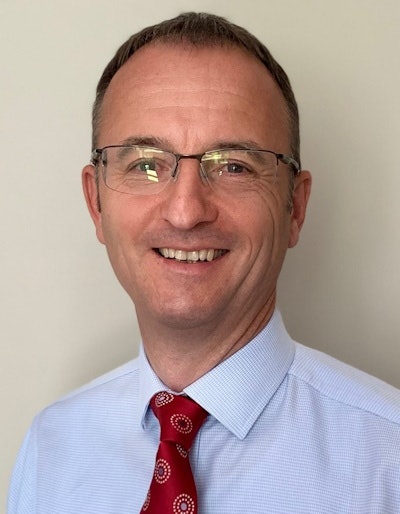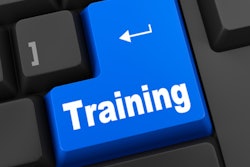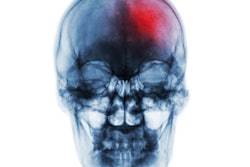
Flexibility and adaptability are important virtues in a pandemic, and these attributes have enabled Dr. Nick Spencer and his team to get through a difficult period for the UK Imaging & Oncology Congress (UKIO 2020), which began earlier this week.
The event in Liverpool had to be canceled and moved online, and it launched on 1 June and is due to run until 14 July. In this question-and-answer interview, Spencer -- who is a consultant radiologist specializing in the head and neck at the Mid Yorkshire Hospitals National Health Service (NHS) Trust -- speaks about the transition to a virtual congress, his clinical role, and the importance of collaboration with radiographers, including role extension. He is also an honorary senior lecturer at the University of Bradford's Faculty of Health Studies.
What does the presidency of such an important meeting mean to you personally?
 Dr. Nick Spencer, UKIO 2020 president.
Dr. Nick Spencer, UKIO 2020 president.Dr. Spencer: It has been both a privilege and a responsibility to become president of UKIO. I began to help in the organization and running of the event five years ago, and I came into a very settled and efficient organization. Maryann Hardy, professor of radiography and imaging practice research at Bradford, originally co-opted me onto the working party. Being president wasn't something I particularly craved or courted, but it just happened to fall into place.
We began to orchestrate the transformation to an online meeting in the middle of March. I was desperate that the congress adapted significantly because of the greater competition from other meetings around the world that are all going online. Also, fewer U.K. radiologists are traveling to RSNA, so it's a very different world now, and I want UKIO to fit into that space as best we can.
Now we've successfully started an online congress, I'd like to think that I was the right person at the right time. It's needed a lot of drive, teamwork, and willingness to be adaptable to make these changes. We're determined to make sure that we build a strong and sustainable meeting into the future.
Can you tell us a little about the approach you're taking and the program?
Dr. Spencer: The number one priority remains our commitment to providing education and professional development for all delegates and exhibitors. We've reworked the program by combining some of the best bits, as well as an e-poster display and short papers sessions of the work submitted. The content is being released in bite-sized chunks and will be available in both live sessions and as on-demand content for delegates.
We're really proud that all sessions are free to access and Continuing Professional Development certificates will be provided. Registration has been very strong so far too. We've already had excellent sessions on sports imaging, musculoskeletal intervention, MRI of the groin, and spinal imaging. Many more sessions are in development and will be added soon, so check the website for regular updates.
The pandemic has preoccupied everybody in healthcare. Have you and your colleagues been involved in the imaging of COVID-19 patients?
Dr. Spencer: Yes, we have been very involved. The department I work in is part of a multisite hospital group. I work in Wakefield, south of Leeds. We were one of the first cities in the North of England to see a spike of cases, and our intensive care unit soon became full, with lots of people coming through the emergency department.
We had to reshape our diagnostic services. A lot of routine pathways have been temporarily suspended, so that we have been able to deliver an almost immediate reporting service for all our patients, particularly chest imaging. In many cases, clinicians have been receiving our reports immediately after acquisition of the images, and that's been instrumental in radiology's contribution to helping with the COVID-19 crisis.
One important aspect is that patients still have a wide range of imaging requirements. For instance, some patients who have COVID-19 may also present with appendicitis or have lung changes on a CT that might arouse suspicion. As we've moved through the crisis, it's become increasingly clear that we have to consider that any patient might have COVID-19.
One of our CT machines has been designated as the scanner only for COVID-19 patients. It has to have a deep clean by clinical and domestic staff between every patient, reducing capacity on that machine to less than one patient an hour. Again, this has required lots of flexibility on everybody's part.
Q: Your region is known as being a pioneer in role extension for radiographers. How have radiographers been affected by the pandemic?
Dr. Spencer: You're right, we have been one of the vanguard sites for delivery of radiographer reporting over the years. For the last decade in my institution, reporting and advanced practitioner radiographers and sonographers have played a pivotal role. That extends to reporting of CT scans, running the obstetric ultrasound service, and a whole range of other areas.
We also have a skilled team of CT and MR radiographers, as well as other health professionals who work to deliver radiology services. My radiographic colleagues are instrumental to the delivery of the service we provide, and probably between 70% and 80% of the workforce has a radiographic background.
So, by making UKIO virtual in 2020, it is more accessible to my team too. As president of UKIO, I'd like to invite all readers to study the online program and register at the UKIO website.



















